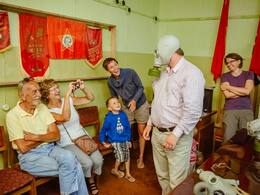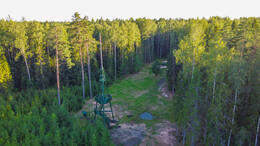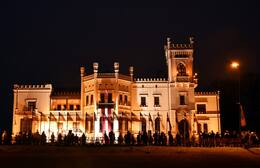Sovietinės okupacijos paveldas Šiaurės Vidžemėje ir Pietų Estijoje
Diena 2.
206 km
Līgatne–Skaļupes–Gulbene–Alūksne
Praktinė informacija
- Driving distance: 206 km
- Due to distances and time, 3–4 of the listed sights can be visited on this day.
- Scheduled excursions in the Secret Soviet Bunker in Līgatne www.bunkurs.lv. Group excursions should be booked in advance. The excursion takes ~2 hours.
- The Secret Soviet Bunker in Līgatne offers a reality game “OBJECT X” (at min. 15 persons) www.bunkurs.lv. Booking in advance.
- There is an audio guide available in Soviet Army Missile base in Zeltiņi, and also a guided tour can be booked +371 29492284.
- Laser Tag in Zeltiņi for max. 12 persons, pre–registration is required visitaluksne.lv
- Opening times for Alūksne Museum www.aluksnespils.lv
Lankytinos vietos
The historical centre of the Līgatne Paper Factory village
The history of Līgatne cannot be separated from the paper factory which was once the only factory of its kind in Latvia. Tours are available in the company of a guide. During the late 19th and early 20th century, the company built homes, a school, a birthing centre, a hospital, a club, a guesthouse and other buildings for its employees, and most of these buildings have survived to this day. There are more than 200 interesting underground passageways which are still used as warehouses for various items, including vegetables.
Secret Soviet Bunker in Līgatne
Located in Līgatne parish, Cēsis municipality, the Soviet Secret Bunker lies 9 metres below the Līgatne Rehabilitation Centre building and its adjacent territory. The bunker is open to visitors and offers guided tours, meals in the bunker canteen, Soviet-style parties and the reality game Object X. The purpose of the bunker was to provide the minimum necessary conditions for long-term work for the Council of Ministers of the Latvian SSR, the leadership of the Communist Council of the LSSR and the management of the LSSR state planning committee in the event of a nuclear war threat. The 2,000-square-metre underground bunker was the strongest autonomous structure with all the required and most state-of-the-art equipment of the time, and also one of the most strategically important sites in Soviet-era Latvia in the event of a nuclear war. The site has a protected underground workspace (shelter), a sanatorium-type sleeping block for 250 people, security facilities and a 24-apartment residential house for service staff. All of the authentic underground equipment and plans have been preserved to this day. Highlights include an autonomous power plant with diesel generators and fuel storage, conditioning equipment for air purification with oxygen reserves, water supply and sewerage equipment operating on the submarine principle, a telecommunications unit capable of providing direct contact with the Kremlin in Moscow and autonomous communications with all major services in the country, a unique map with historical names of collective farms, an authentic canteen with typical Soviet-era meals, as well as various Soviet-era attributes and household items.
Soviet Army Missile base in Zeltiņi
The former Soviet Army Missile Base is located in Medņukalni, Zeltiņi parish, Alūksne municipality. This nuclear missile base was a particularly secret military facility of the Soviet Army, and it operated in Zeltiņi, Alūksne municipality, from 1961 to 1989. The facility housed P-12 (8K63) and P12Y (8K63Y) surface-to-surface medium-range ballistic missiles with 4 launch pads. Their travel distance was 2,200 kilometres. During this period the army used barbed-wire to secure an area of about 300 ha less than a kilometre from the Sinole-Silakrogs P34 national regional highway. The living and top-secret areas have remained a legacy even today. Concrete roads lead to places hidden from the eye at that time: hangars, launch pads and bomb shelters. Various structures for the maintenance and servicing of nuclear missiles are located on an area of dozens of hectares. Facilities providing the area with the autonomous supply of power, water and heat were destroyed with the withdrawal of the army. After the army left, some of the equipment was handed over to the local municipality. Visitors currently have access to 20 ha of the former territory of the missile base, the south-western part of which is a tourist attraction. Tourists visiting the base can choose between the core exhibit about the history of the missile base, which is located in the Zeltiņi Museum, and a tourist route in the base area. Friends in a group of up to 12 people can enjoy a game of laser tag here.
Gulbene Railway Station
The Gulbene Railway Station is located in the city of Gulbene. During World War I, in 1916 to 1917, the narrow-gauge railway line to Pļaviņas was reconstructed to 1,524 mm width to ensure that it can serve as a connection to the Rīga-Daugavpils line. In addition, a railway line to Ieriķi and to Sita was constructed, thereby establishing a connection with Pytalovo. As a result, Gulbene became a railway hub. The current station building by architect Pēteris Feders was constructed in 1926. During the War of Independence, on 31 May 1919, when Gulbene was liberated from the Bolsheviks, the 1st (4th) Valmiera Infantry Regiment collected a significant number of war trophies here. On 14 June 1941, both civilians and Latvian Army officers arrested in the Litene Summer Camp were deported from the Gulbene Railway Station. As a key hub, it was bombed in the spring of 1944. After the war, it was restored to its original form. An educational and interactive centre named ‘Railway and Steam’ was opened in 2018. Next to the Gulbene station is the company SIA Gulbenes – Alūksnes bānītis, which offers interactive lessons and tours. Visitors have access to the station building and platform, a memorial plaque and a monument to the repressed ones by sculptor Indulis Ranka.
Latvian Army Summer Camp in Litene
The Latvian Army Summer Camp in Litene is located in the forest in Litene parish, near the Pededze River. The beginnings of the Litene Camp can be traced back to 1935 when the construction of a summer camp complex for the Latgale division of the Latvian Army was started. From May to autumn, several thousand soldiers learned combat tactics and shooting skills in Litene. In the summer of 1941, Latvian Army officers were arrested by Red Army and NKVD troops at an army summer camp in Litene. Several officers were shot on the spot, while others were deported to Siberia. On 14 June 1941, at least 430 officers were arrested and deported to Siberia in the Litene and Ostrovieši camps about 10 kilometres from Litene. The only historical building that has survived from the camp is a food storage facility. Only the foundations remain from the other buildings. There is a viewing platform with the Latvian flag, benches and a well-maintained place for a fire. A demilitarised cannon was installed with the support of the Ministry of Defence and the National Armed Forces. Information boards are in place. The Wall of Pain memorial in the Litene graveyard is also connected with the events at the Litene camp. The YouTube channel of the Latvian Army features a video named ‘Litene, Katyn of the Latvian Army’.
Alūksne Museum
The Alūksne Museum is located in an architectural monument of national significance: the neo-Gothic Alūksne New Castle built in the late 19th century. The museum features an exhibition named ‘Memorial Room for Victims of the Totalitarian Regime’, which tells about the fate of the inhabitants of Alūksne municipality in Siberia and the Far East, while the time periods from prehistory to the present meet in the Alūksne history exhibit ‘Feast of the Ages’. It features a separate section devoted to the contribution of the 7th Sigulda Infantry Regiment to the military, culture and public life. The formation of the 7th Sigulda Infantry Regiment began on 20 June 1919 in the Naukšēni Manor. Initially, a battle group of 22 officers and 1,580 soldiers was formed from the reserve battalion of the Northern Latvian Brigade, and was named the Dankers Division. It was included in the 2nd Battalion of the 3rd Jelgava Regiment. On 23 August, following an increase in the number of companies, it became part of the 7th Sigulda Infantry Regiment. Having taken part in the battles against Bermondt, on 5 January 1920, the regiment was transferred to the Latgale front to fight the Bolsheviks. After the signing of the Peace Treaty with Soviet Russia, the regiment guarded Latvia’s eastern border. The Latvian War of Independence saw the deaths of more than 200 soldiers of the regiment, while 85 were awarded the Lāčplēsis War Order. In 1921, the 7th Sigulda Infantry Regiment was stationed in Alūksne. The regiment’s headquarters were set up in the Alūksne New Castle. After World War II, the castle was taken over by Soviet security institutions. As of the late 1950s, the castle housed various cultural institutions: the Culture and Cinematography Department of the Executive Committee, a pioneer house, a library, a cinema and a museum.
Vietos pavalgyti
Hotel and restaurant VECGULBENES MANOR
Four-star hotel and restaurant of Vecgulbenes manor is located in a beautiful historic place, in a renovated horse arena building that was the largest closed arena in the Baltics.
In Gulbene www.visitgulbene.lv
In Alūksne visitaluksne.lv
Vietos apsistoti
HOTEL BENEVILLA
Small style hotel (6 rooms) - a cafe located in the historical center of Aluksne, 10 minutes walk from the Livonian castle ruins. Many of the hotel’s rooms have wonderful views, including to Alūksne Evangelical Lutheran Church, Cultural Center, art school, lake. Alūksne Castle Island or Marija Island is nearby; from there you can get to Tempļakalns park via a pedestrian bridge. Prepare your own fresh (frozen) berry ice cream, cakes and custom dishes. Seasonally offers different varieties of fruits and berries: strawberries, apples, pears. Orchard 3 km from the town with 1000 fruit trees.
Bahnhofs Hotel
The only Art Nouveau building in Aluksne, built at the beginning of the 20th century, now works as a hotel. Historically, the building once housed a Railway hotel, so the original name of the hotel - "Bahnhofs Hotel" (transl. from German - "Railway" hotel) was kept.
The hotel has 9 rooms (some of which extra beds can be arranged). At an additional cost an English-style breakfast is available. Hotel guests are offered a half-hour free access to the swimming pool at hotel "Jolanta", which is nearby, as well as electric scooter and bicycle rental.
A banquet hall is also available for various events.
N.B. Hotel bookings must be made at least 12 hours before arrival.
DUKI
If you want to relax at the natural world and away from the hustle, crowds of people, rows and other civilizations 'achievements' - then the possibility still exists "Duki". Here you will have a comfortable accommodation equipped country house with 25 hectares of land without fences, no neighbors behind the wall. You are ready to enjoy the picturesque River Pededzes flowering and green meadows. For your convenience, house is equipped with the necessities of rest and comfort to ensure
BITĪTES
20 km from Alūksne, a house for parties. Ponds for fishing, spin-casting, swimming. Smokehouse for fish, dance area, separate country sauna.
In Alūksne visitaluksne.lv












